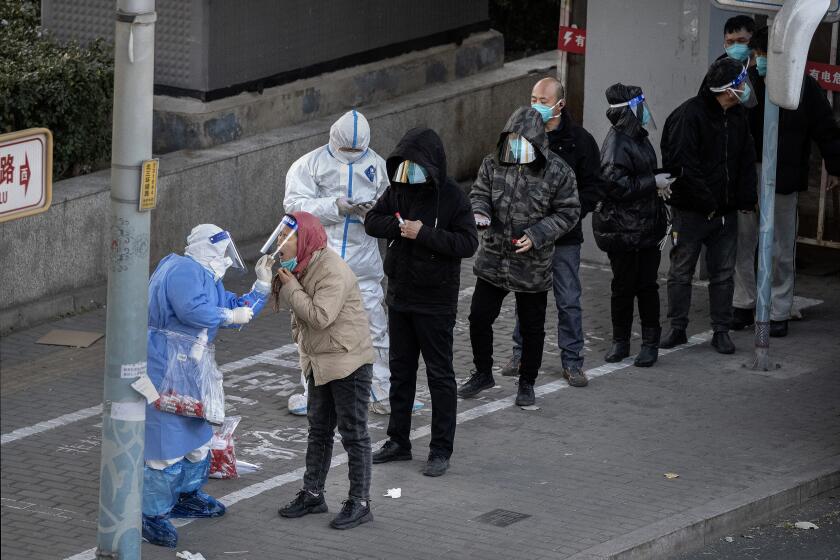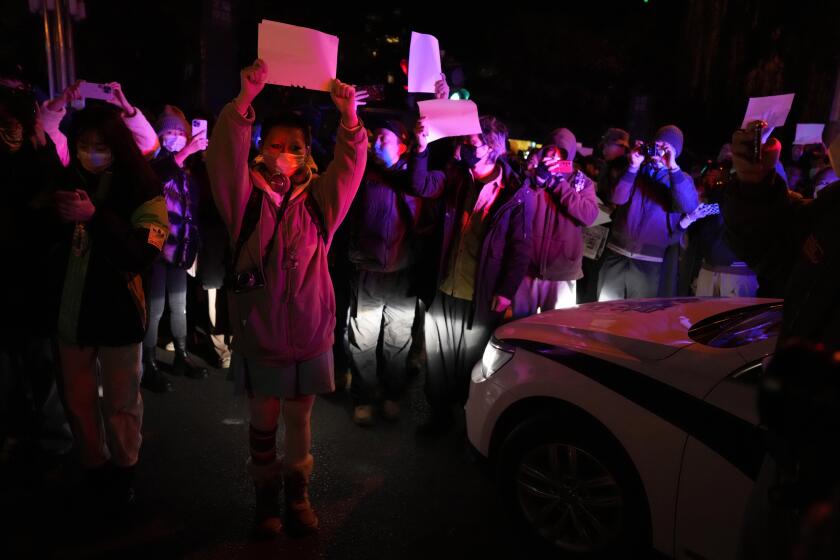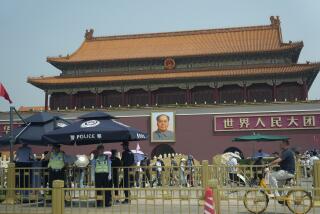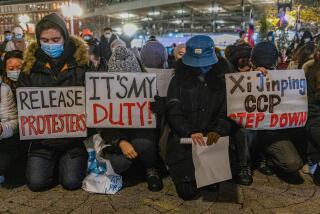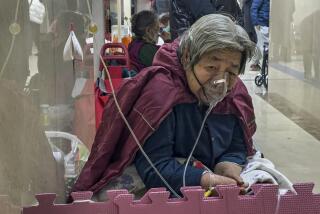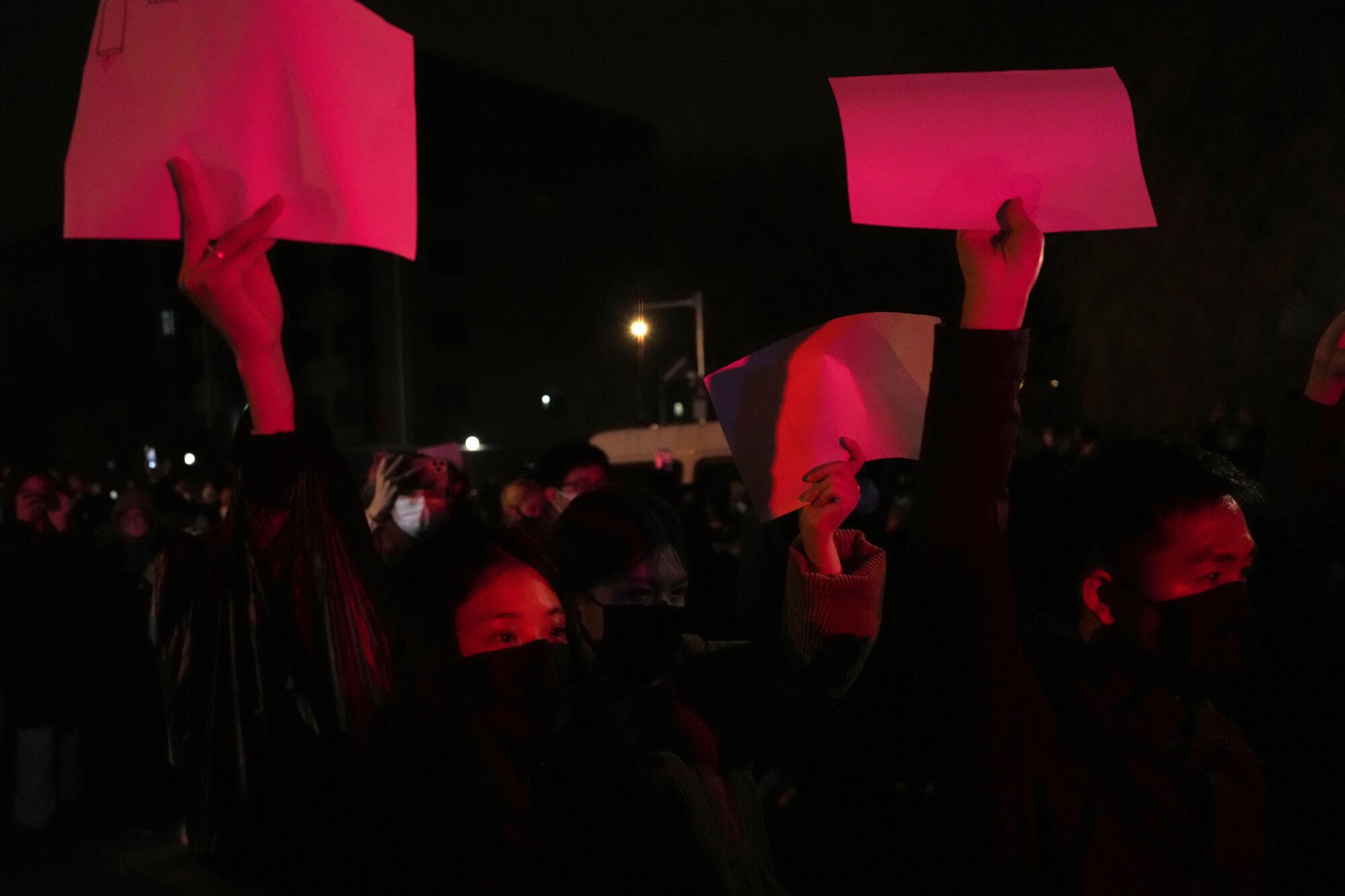
- Share via
TAIPEI, Taiwan — It was the middle of the night in Shanghai when Jack’s phone rang, with a message from a friend: Something big is happening.
That message was already spreading across social media, momentarily overwhelming Chinese censors. As the evening of Nov. 26 progressed, hundreds gathered downtown for a vigil on Urumqi Road. They began to chant, calling for an end to COVID-related lockdowns and endless PCR tests. Some shouted for free speech and press freedom. Others went so far as to demand that President Xi Jinping and the Communist Party as a whole step down.
The very thought of joining the crowd made Jack nervous. But the 23-year-old, who declined to give his Chinese name for fear of retribution from authorities, said he needed to see it for himself. He got out of bed, called a cab and, in less than 20 minutes, joined his first protest in China.
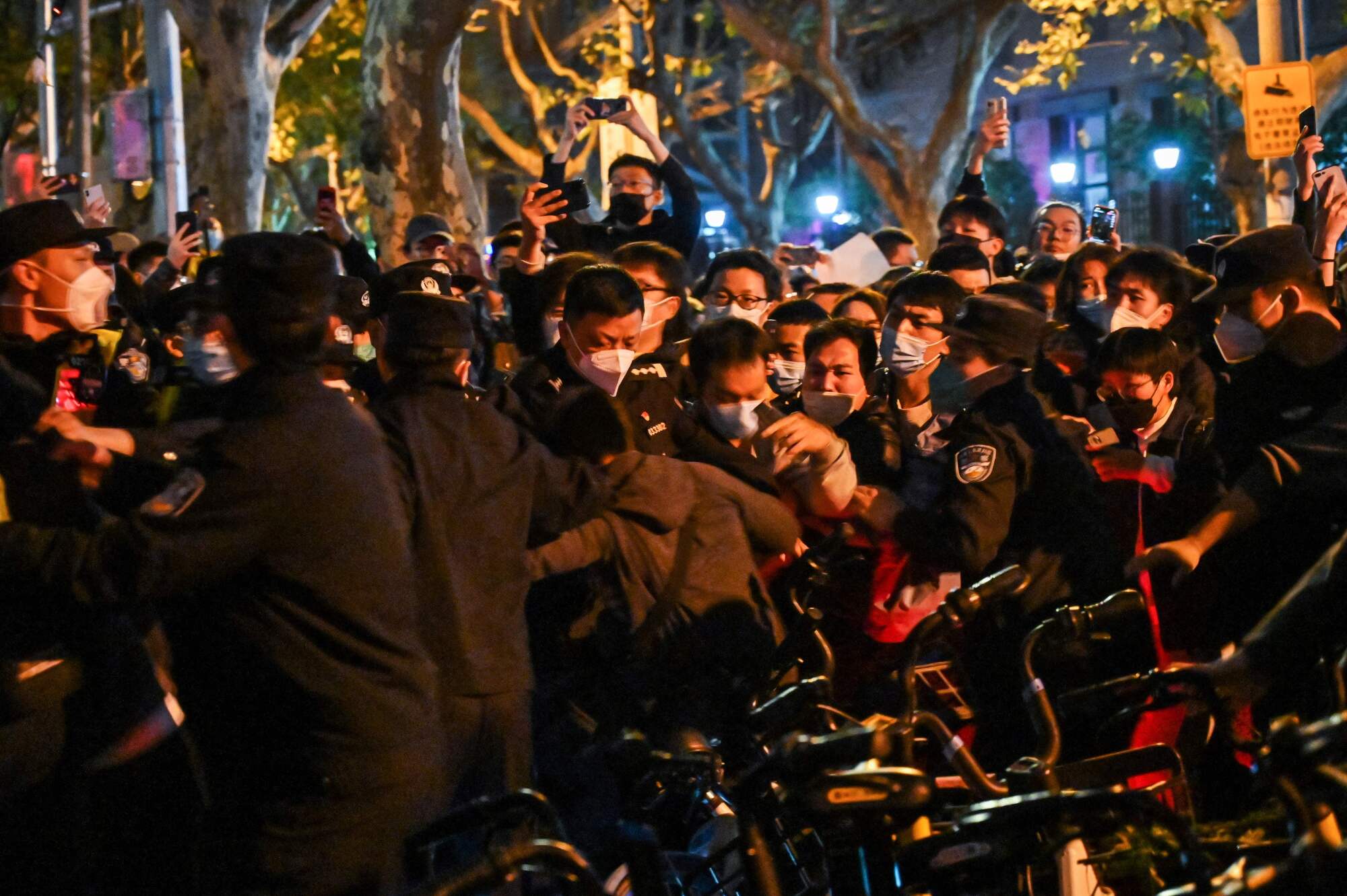
“To be honest, I didn’t have any set goal,” he said. “Maybe our actions that night were ultimately futile. But I just felt that it was a necessity, an obligation, to stand with them.”
That weekend, thousands of residents across multiple cities rallied for change. They sang anthems and held blank sheets of paper in rebuke of China’s pervasive censorship. Together they made up the country’s largest-scale protests since 1989, when demands for democracy culminated in a bloody military crackdown in Tiananmen Square on June 4, causing hundreds and possibly thousands of deaths.
But beyond the size and breadth of the crowds, comparisons between then and now are limited because of China’s transformation over the last three decades. The last time mass protests demanded democratic freedoms, the country was just beginning to open up to the rest of the world. Now the world’s second-largest economy, China is increasingly closing itself off, as Xi has consolidated his hold on industry and society and built a sophisticated surveillance state under one-man rule.
Today, wide-scale organized mobilization is virtually unheard of, as growing government control has decimated spaces for political discourse or activism. But Beijing appears to have taken some heed: Without explicitly acknowledging the unrest on the streets, it has accelerated relaxation of its strictest COVID measures. On Wednesday, China’s National Health Commission announced that it would limit the scale of lockdowns, allow people who test positive to isolate at home and abandon mandatory testing for access to most public places.
In a sharp reversal, China has announced a series of measures rolling back some of its most rigid ‘zero-COVID’ restrictions.
At the same time, the government has bolstered security to discourage further demonstrations. What made the recent protests possible was the fact that they were largely spontaneous. That lack of organization may undermine the fledgling movement’s ability to sustain itself, leaving a political awakening with little room to run.
“It’s probably more of a moment than a movement,” said Jeffrey Wasserstrom, a historian of modern China at UC Irvine. “That said, the skills that people get from moments are things they can use the next time a moment comes along.”
::
In the 1980s, China saw rapid growth and modernization under Deng Xiaoping’s embrace of economic development and openness. Such changes emboldened students to push for more reforms, including free speech, a free press and an end to government corruption. Similar to today, protests broke out several times in the years before 1989. But it was the death of Hu Yaobang, a party leader who pushed for democratic reforms before his forced resignation, that sparked mass gatherings across the country.
In April 1989, tens of thousands of people congregated in Tiananmen Square to commemorate Hu and demand change. As the crowds grew, Communist Party officials were conflicted about how to meet the challenge. Some wanted to negotiate with the protesters, while others advocated suppression by force.
The latter group won out. By the end of May, the government had enacted martial law to dispel the demonstrations. On June 4, armed troops and tanks entered Tiananmen Square, where protesters were still gathered, and opened fire. Afterward, the government rounded up remaining dissidents and reasserted control.
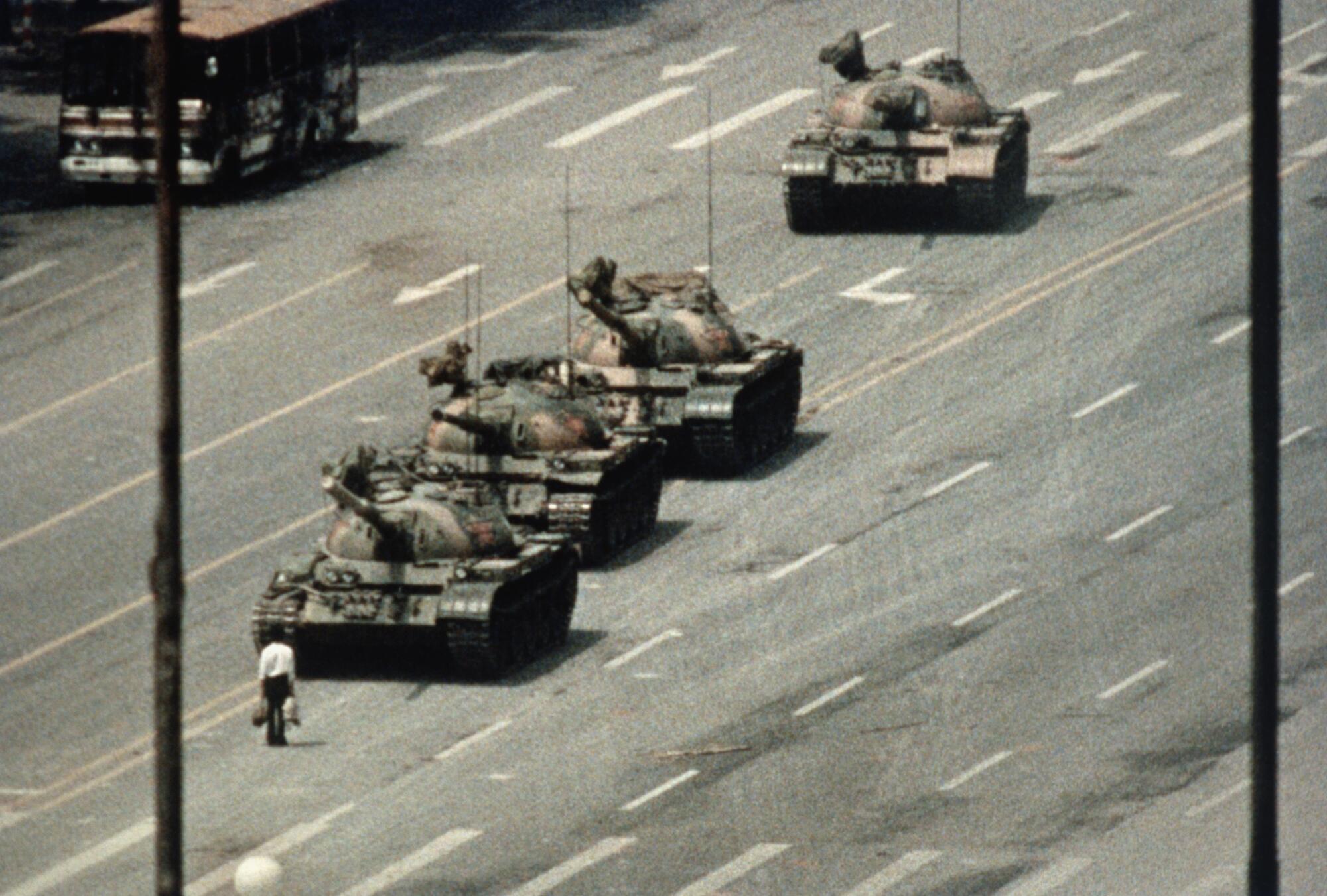
Though any mention of the event is strictly taboo in China’s official records, some of today’s young protesters referenced the student-led movement of 1989, noting that while the recent demonstrations did not see the same mass organization or brutal crackdown, they could have their own significant role in history.
“This is the protest of our generation,” Jack said. “If there is opportunity, I will definitely return to the streets.”
::
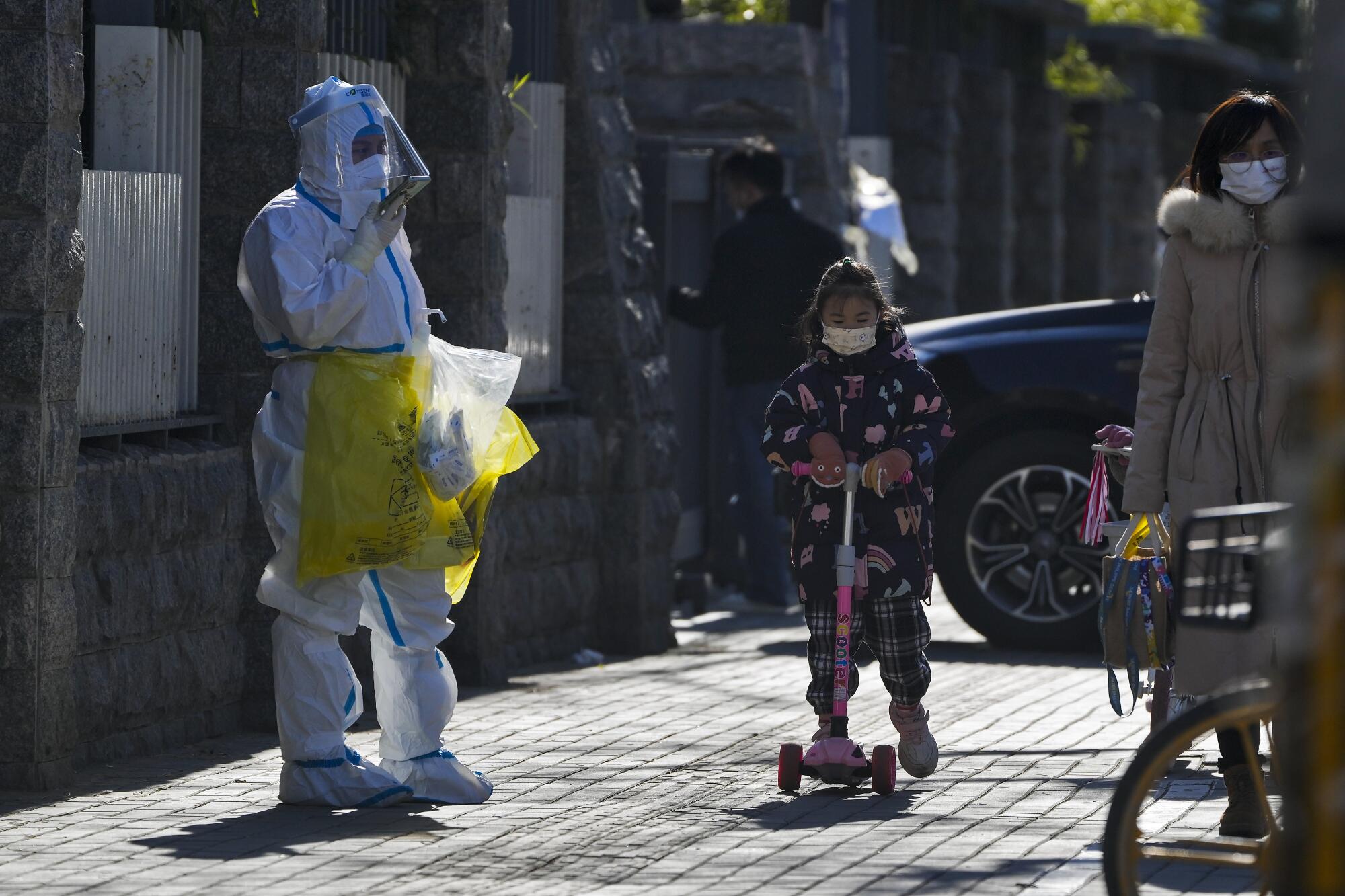
The recent unrest started with an apartment fire in Urumqi, the capital of the Xinjiang region, that killed at least 10 people Nov. 24. Many blamed stringent “zero-COVID” measures that they suspected had trapped victims inside and kept firefighters at a distance. Local protests erupted the next day, calling for an end to a lockdown that had stretched on for more than three months.
As the demonstrations spread to other cities such as Beijing, Shanghai and Chengdu over the weekend of Nov. 26-27, the sudden uproar caught authorities off guard. Many protests began as vigils honoring the victims of the Urumqi fire, but as more people joined in, public anger over three years of hard lockdowns and a contracting economy boiled over. Since Nov. 25, more than 60 similar protests have broken out across China in 31 cities, according to geospatial analyst Nathan Ruser and his colleagues at the Australian Strategic Policy Institute.
Though protests occur regularly in China, they tend to be focused on specific demands over things like land, labor or pay. But in the last three years, the pursuit of “zero COVID” has led to unprecedented government oversight over people’s lives, spurring solidarity across cities and social classes.
“Usually these strands of protests are completely distinct and disparate,” said William Hurst, a University of Cambridge professor who studies politics and protest in China. “For this brief moment, at least, they’re all united.”
Protesters in China are eager to see an easing of “zero-COVID” rules, but health experts warn that doing so could prompt a massive health emergency.
Lockdowns have confined residents to their homes for months on end, at times leaving them without food or medicine. Minor revolts have broken out in residential communities over extreme restrictions. Other tragedies have exemplified the consequences of the government’s unyielding pandemic policy — a bus crash in Guizhou that killed 27, or a 3-year-old who died from carbon monoxide poisoning — and have prompted waves of public vitriol online.
Last month, workers at Foxconn, which assembles iPhones and other electronics for Apple, fled a factory lockdown in Zhengzhou as the virus spread on site. Others who stayed clashed with authorities there over pay and pandemic restrictions.
Like others in Shanghai or in Urumqi, Jack, who works in advertising, knew what it felt like to be locked down for months. From March until May, he was quarantined in a Shanghai hotel with only a fire escape ladder to go up and down from his room. One day he found that the ladder had been blocked with mesh wire.
“I could really relate to the tragedy of the Urumqi fire,” Jack said. “Anyone in China who has been in lockdown, they can all feel this too.”
::

In the last 30-plus years, the Communist Party has worked to suppress individuals and organizations that could threaten political stability again. Such efforts have been accelerated under Xi, who recently secured his third five-year term at the head of a governing body stacked with his loyalists. The government has jailed dissidents, activists and lawyers, and pressured advocacy groups that champion causes like worker rights and gay rights. Few in China are left with the experience or networks to organize any meaningful opposition.
Knowing the government’s penchant for control, many of the recent protesters said they didn’t expect much change. Some were torn between focusing on “zero-COVID” complaints and pushing for more political freedoms or even regime change, which they considered extremely unlikely.
As the country’s expansive security apparatus has moved into action, momentum has fizzled over the last 10 days. Heightened police presence has deterred would-be protesters. Access to mobile data allows authorities to monitor messages and travel history, tracking down and singling out participants. In Shanghai, officers have been checking civilian phones for apps like Telegram that are used to circumvent Chinese censorship and surveillance.
“When it’s organized, the state always knows all the details,” said Chloe, a 27-year-old Shanghai resident who requested to use her English name.
Chloe thought she knew the risks when she went to Urumqi Road last month. Though she didn’t expect to fool many surveillance cameras, she and a friend wore face masks. She considered returning to more demonstrations if it seemed safe, but the subsequent state pressure has left her afraid, angry and devastated. A friend was detained at another rally, and returned emotionally shaken and scared. She watched as someone else she knew was beaten by the police.
U.S. officials say the Biden administration supports the right to protest, but have offered little more.
“I knew they were gonna take extreme measures, but their abuse of power and violence was still beyond my imagination,” she said. “I don’t think any protest is gonna happen here anytime soon.”
The government’s recent loosening of coronavirus rules may appease some residents, but others remain skeptical of its ability to follow through. A safe and effective easing of “zero-COVID” measures could help defuse public anger, while a failure to do so could invoke further turmoil and undermine the party’s authority.
“In the long run, it might actually be hurting the regime as a whole, because people’s grievances are accumulative,” said Rongbin Han, an associate professor specializing in Chinese media and politics at the University of Georgia. “It’s like a dormant volcano. If the grievance is still there, people are likely going to rise again when opportunities emerge.”
For some, the frustrations have extended beyond China’s “zero-COVID” policy and into the influence the government exerts in nearly all aspects of life.
Jay Yuan, who attended Shanghai’s protests last weekend, pointed to several other tragedies this year: a woman found chained up in Fengxian county in February, an Eastern Airlines plane crash that killed 123 people in March, a brutal attack on several women in the city of Tangshan in June. The silences from authorities after each incident have rankled too.
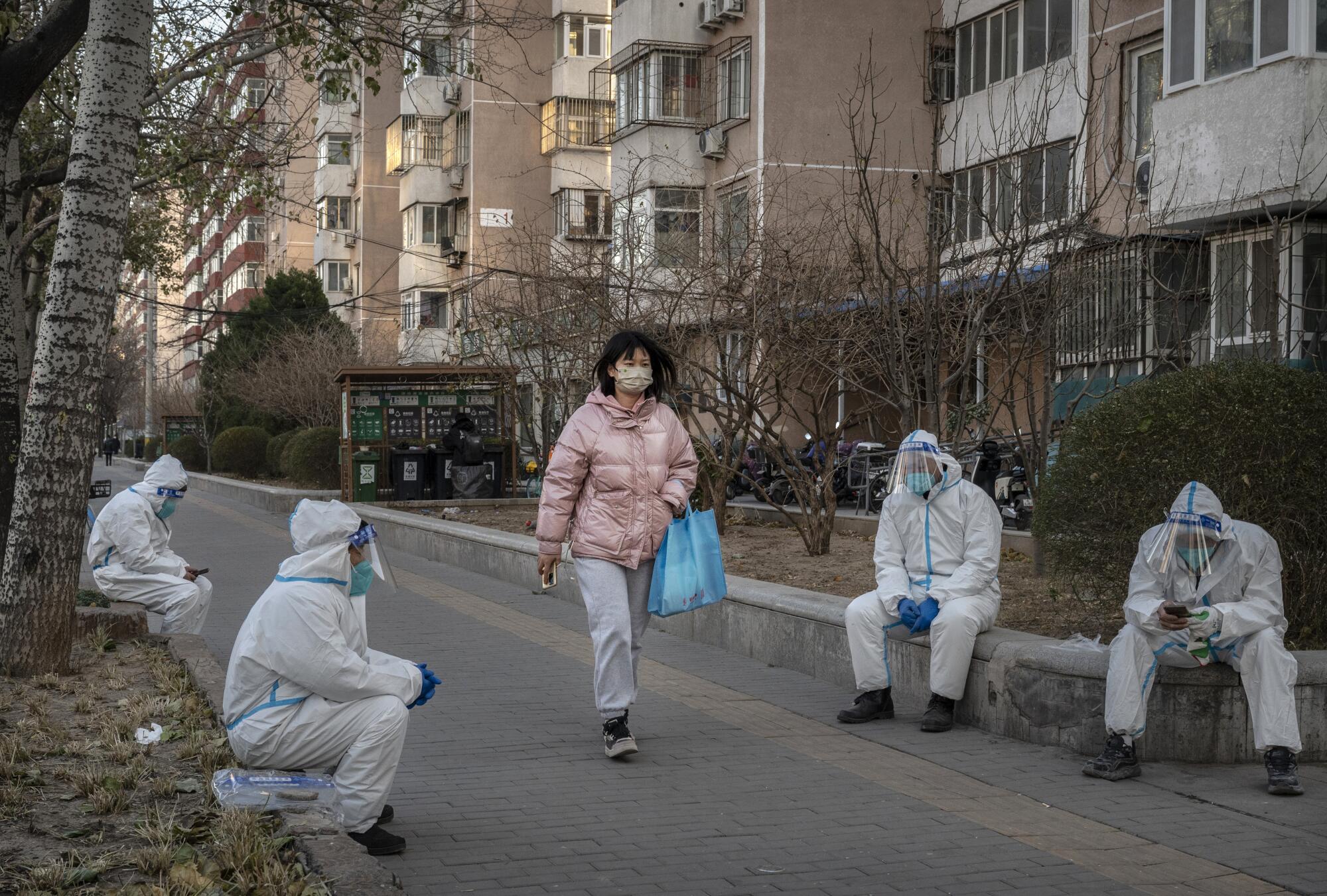
“Since the pandemic, there’s been so many things that have infuriated people,” the 26-year-old said. Even his college friends, who once mocked those who criticized China or its government, are becoming disillusioned. “More and more people are starting to realize, actually, China isn’t as great as they think.”
Zhang, a 27-year-old in Shanghai who gave only his surname, said he didn’t realize so many others were also dissatisfied with Xi until the first night of protests on Urumqi Road. While his heart was pounding in fear, he also remembers the palpable strength of the crowd as they chanted together.
The speed and ease with which the police broke up the demonstrations drove home how inexperienced they all were, but Zhang still believes the incident will encourage more people to question authority and voice their own opinions.
“Although I think this protest died early, it was still significant,” he said. “It may not have had much direct impact, but it made more people willing to express themselves.”
For now, Zhang said that authorities have made gathering nearly impossible. So he has retreated back to the online world to seek new ways to evade China’s censors, and wait for the next chance to speak out.
Yang is a Times staff writer and Shen a special correspondent.
More to Read
Sign up for Essential California
The most important California stories and recommendations in your inbox every morning.
You may occasionally receive promotional content from the Los Angeles Times.

